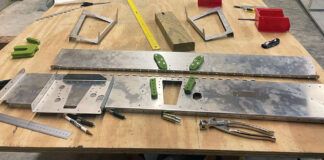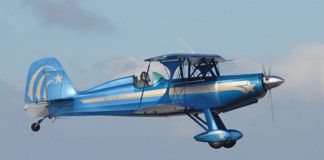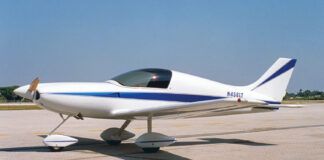It’s a first-world problem—I admit it. With too many airplanes in our little fleet, there is always something to be worked on, or an airplane that just needs to be flown to keep the fluids fluid and the battery charged. That means that we have been violating Rule #1 in finishing a homebuilt airplane project when it comes to our Xenos motorglider: Make sure to do a little work on it every single day, even if it’s just cleaning up the shop. Life (and other airplanes) tend to get in the way, so the Xenos gets attention in fits and spurts, when we seem to be caught up (or at least gaining on) all of the other little chores associated with airplane ownership and airpark living. Like I said, first-world problem.
But recently, we’ve been enjoying a little more time with the project plane, specifically, building the main wingspars. With a 46-foot wingspan, the Xenos presents ample opportunity to work on spars because, well, they’re ample! Since the root end of each spar crosses the cockpit, overlapping the other, the total length of the two spars exceed the finished span of the airplane, making for even more fun.
Built from custom aluminum extrusions, the caps are works of art, and they change shape and size constantly from root to tip. The webs are built up of different layers of aluminum sheet, varying from .032-inch thick out near the tips to a combined thickness of 1/8-inch layers measuring over 3/4-inch at the root. Various lightening holes, bolt blocks, rib flanges, and other accessories make them quite complicated for such a simple airplane.
Before we even started assembling the spars themselves, we spent a fair amount of time fabricating components. The inner wing rib attachment flanges, for instance, are about 7-inch long aluminum sheet angles, each with its own unique dimensions, shape, and rivet pattern. Forward and aft pieces for each rib station are unique, of course, and the overall shapes of the seven or eight stations are at least symmetrical for the left and right spars. These flanges are attached to the spar when it is built (and the ribs themselves scabbed on later) because they get fastened to the primary spar assembly with the big -5 (5/32-inch diameter) rivets that predominate throughout the structure. Driving those -5 rivets takes a little more work then the -4 (1/8-inch diameter) pulled rivets that are used to primarily build the rest of the airplane.
Mocking up the spar and match drilling the holes was a job that took most of two months’ worth of spare time. The drawings are complete and very dense when it comes to important information, and the spar is far more complicated that you might expect. Getting all of the layers of pre-punched web material in the right order and located in the proper spots from root to tip was a lovely puzzle, satisfying in the end when it was complete. Upsizing all of the pre-punched holes and match-drilling the spar caps into the assembly took varying sizes and lengths of drill bits and constant reference to those drawings. While the thin sandwich at the tip end could be fastened with regular -5 Clecoes, the thick root ends presented a bit of a conundrum. Wing-nut Clecoes cost about $3.50 each, and there were hundreds of holes that needed to be filled. But many of them were so close to the spar cap that there wasn’t room for the body of the long-reach temporary fasteners. Fortunately, the -5 rivets require a #21 drill bit, which happens to match perfectly with a metric 4mm machine screw, so we obtained a box of those, along with appropriate washers and nuts, to temporarily fasten things together. A little more tedious than Clecoes, yes, but much more economical and a small fraction of the overall time it will take to build the spar.
Let’s just skip over the part where we had to disassemble everything, deburr (for a week of evenings) and reassemble…shall we?
Finally, we are in the process of driving home the hundreds of rivets that will hold these miracles of engineering together for good. Solid rivets don’t phase us at all; we’ve been working with them for many years on lots of different airplanes. The -5 rivets do, however, require a bit more oomph to set than the little -3 or -4 fasteners used in building most light-aircraft assemblies. But where there is a need, the right tool can be found. Enter a custom-built pneumatic squeezer provided by a builder/craftsman we know just over the mountains from us. When I went to pick it up in my RV-8, I had to go alone because its weight took up the passenger allowance (and that seat). Set on a small bench stand in the middle of the workspace, the spar travels through the yoke and is supported on each side by roller stands like you’d use to handle long boards on either side of a table saw.
This custom-built pneumatic squeezer made it easy to set large -5 rivets. The spar travels through the yoke and is supported on each side by roller stands like you’d use to handle long boards on either side of a table saw.
So now we’re driving rivets—but there are very few alike, making it hard to get into “production mode.” With the thickness of the spar web varying from root to tip, the length of the rivets change also. Just when you think you’ve got everything set and you’re rolling along, you have to change the setup. Then one of those rib flanges comes along, and you have to open up the yoke to get around it, then hunt for your setting again. It’s a fine misery as they say. Being in the shop is rewarding, but you have to put up with the little things that slow you down at every step. It’s all part of the game.
I figure that with our current schedule, we’ve got another few weeks to go to get this left spar finished. Then we will pull out all the virgin parts for the right side and get started on that one. In retrospect, it’s a good thing we’ve got other airplanes to fly, for this could take awhile. But we love to build, and love to fly—so having both options available at the same time is the best of both worlds.
Excuse me now, I hear some rivets calling to me from out in the shop. A homebuilder’s work is never done…














